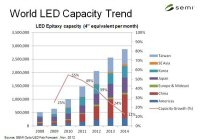
If you’ve ever looked directly at a retrofitted LED luminaire in a parking structure or gas station canopy, chances are you were blinded by the glare. And when you looked away you probably saw those black spots reminiscent of antiquated flash cameras. This happened to me just last week. As a lighting product manager and mechanical engineer I often look up at the lighting source; try as I might, I simply can’t avoid it! Since you’re reading LED Journal, you undoubtedly do this too.
So why do covered ceiling and area light luminaires have exposed LEDs? Such a design model virtually ensures glare. Yet as a lighting professional, I often wonder why LED fixtures are being developed with such little regard for glare control. While there is no clear answer, I’d suggest two strong possibilities: the first is that lighting manufacturers were initially so consumed with lumen output that a feature that would lower light output was not part of the discussion. Lighting specifiers were skeptical, at best, that a parking garage could be properly illuminated with a 3,000 to 4,000 lumen fixture, costing $700 and lasting only 50,000 hours—so where was the value proposition? The manufacturers were making seemingly outlandish statements that only delivered lumens mattered, and a parking garage could be magically illuminated with what appeared to be ¼ the total amount of light output from the luminaire.
The second reason, in my opinion, is that manufacturers and specifiers both believe the new designs are an improvement over the old shoe-box designs normally used in area light applications. Post-top mounts were certainly more attractive, but new stray light ordinances have slowed their sale so many specifiers perceive these designs as new and fresh.
Standards -Yes, fresh design aesthetics are definitely appealing! That said, I don’t believe that modern LED luminaires should be held to a lower standard regarding glare control or that modern LED luminaire designs should be exempt from the standards and practices meticulously developed over the last 100 years.
Measuring Glare – Since glare can be quantifiable through a standard luminance measurement, this issue is far more significant than one person’s opinion versus another’s. As you may know, luminance is the photometric measure of the luminous intensity per unit area of light travelling in a given direction. Luminance describes the amount of light passing through a specific area that falls within a particular angle.
A common mistake in measuring LED luminaire luminance is measuring the entire fixture. Luminance must be measured at the luminous opening, in other words at the smallest point (without any breaks) that emits light out of the fixture. If one were to measure the entire LED luminaire, it would not account for the “shards” of light emitted from each individual LED. The light emitted from individual LED luminaire designs is more akin to a series of laser beams in contrast to the homogenous output of a traditional luminaire.
I don’t want to dive too deep into the mathematical equations or the comparison of luminance values, since not everyone following this blog is an engineer. However, it’s important to point out that in controlled tests, results showed quantitatively that a shielded LED luminaire yielded an eightfold reduction in glare.
LED Luminaires Redesign Needed – Most LED luminaires designed today do not address the issue of glare. To the contrary, glare is often completely ignored. Clearly, as was done with traditional light sources, manufacturers should address LED glare, because high efficacies and quality distributions can be maintained while controlling both discomfort and disability glare.
I believe glare is just as important an issue today as it was 20 years ago. Unfortunately, with the impracticality of physical testing, there is no easy way to compare one luminaire to another when specifying fixtures for a project. However, there is one important point I’d like to make and that is, as with incumbent lighting technologies, new LED luminaires should not be designed with unshielded lamp sources. Effective shielding of LEDs can be achieved, while still providing excellent performance and a dramatic reduction in glare.
You may have a different opinion and I welcome your comments and feedback.









